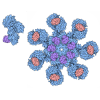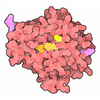+ データを開く
データを開く
- 基本情報
基本情報
| 登録情報 |  | |||||||||
|---|---|---|---|---|---|---|---|---|---|---|
| タイトル | Binary cluster of TNF-TNFR1 ectodomain complex | |||||||||
 マップデータ マップデータ | ||||||||||
 試料 試料 |
| |||||||||
 キーワード キーワード | TNF receptor / Receptor / Receptor cluster / IMMUNE SYSTEM | |||||||||
| 機能・相同性 |  機能・相同性情報 機能・相同性情報positive regulation of amide metabolic process / tumor necrosis factor receptor superfamily complex / pulmonary valve development / negative regulation of L-glutamate import across plasma membrane / negative regulation of bile acid secretion / response to Gram-negative bacterium / positive regulation of neutrophil activation / negative regulation of branching involved in lung morphogenesis / positive regulation of interleukin-33 production / positive regulation of fractalkine production ...positive regulation of amide metabolic process / tumor necrosis factor receptor superfamily complex / pulmonary valve development / negative regulation of L-glutamate import across plasma membrane / negative regulation of bile acid secretion / response to Gram-negative bacterium / positive regulation of neutrophil activation / negative regulation of branching involved in lung morphogenesis / positive regulation of interleukin-33 production / positive regulation of fractalkine production / positive regulation of blood microparticle formation / positive regulation of chronic inflammatory response to antigenic stimulus / positive regulation of lipid metabolic process / aortic valve development / tumor necrosis factor receptor activity / positive regulation of leukocyte adhesion to arterial endothelial cell / positive regulation of vitamin D biosynthetic process / response to 3,3',5-triiodo-L-thyronine / response to macrophage colony-stimulating factor / positive regulation of protein transport / negative regulation of extracellular matrix constituent secretion / positive regulation of translational initiation by iron / positive regulation of apoptotic process involved in morphogenesis / regulation of membrane lipid metabolic process / regulation of endothelial cell apoptotic process / chronic inflammatory response to antigenic stimulus / regulation of branching involved in salivary gland morphogenesis / negative regulation of protein-containing complex disassembly / positive regulation of humoral immune response mediated by circulating immunoglobulin / positive regulation of hair follicle development / response to gold nanoparticle / negative regulation of myelination / TNFs bind their physiological receptors / negative regulation of cytokine production involved in immune response / negative regulation of vascular wound healing / negative regulation of amyloid-beta clearance / tumor necrosis factor binding / positive regulation of interleukin-18 production / inflammatory response to wounding / negative regulation of cardiac muscle hypertrophy / death receptor agonist activity / positive regulation of action potential / TNF signaling / epithelial cell proliferation involved in salivary gland morphogenesis / toll-like receptor 3 signaling pathway / embryonic digestive tract development / negative regulation of D-glucose import / vascular endothelial growth factor production / leukocyte migration involved in inflammatory response / positive regulation of fever generation / response to fructose / positive regulation of neuroinflammatory response / necroptotic signaling pathway / positive regulation of synoviocyte proliferation / positive regulation of calcineurin-NFAT signaling cascade / leukocyte tethering or rolling / positive regulation of mononuclear cell migration / positive regulation of hepatocyte proliferation / negative regulation of myoblast differentiation / positive regulation of protein-containing complex disassembly / regulation of establishment of endothelial barrier / endothelial cell apoptotic process / negative regulation of oxidative phosphorylation / regulation of tumor necrosis factor-mediated signaling pathway / cellular response to toxic substance / positive regulation of protein localization to cell surface / positive regulation of osteoclast differentiation / macrophage activation involved in immune response / tumor necrosis factor receptor binding / negative regulation of systemic arterial blood pressure / positive regulation of heterotypic cell-cell adhesion / positive regulation of cytokine production involved in inflammatory response / positive regulation of macrophage derived foam cell differentiation / regulation of immunoglobulin production / TNFR1-mediated ceramide production / positive regulation of programmed cell death / negative regulation of mitotic cell cycle / positive regulation of membrane protein ectodomain proteolysis / positive regulation of podosome assembly / positive regulation of extrinsic apoptotic signaling pathway / positive regulation of chemokine (C-X-C motif) ligand 2 production / response to L-glutamate / regulation of canonical NF-kappaB signal transduction / regulation of fat cell differentiation / positive regulation of leukocyte adhesion to vascular endothelial cell / TNFR1-induced proapoptotic signaling / negative regulation of bicellular tight junction assembly / regulation of metabolic process / regulation of reactive oxygen species metabolic process / positive regulation of DNA biosynthetic process / prostaglandin metabolic process / negative regulation of heart rate / positive regulation of amyloid-beta formation / negative regulation of viral genome replication / response to isolation stress / regulation of synapse organization / negative regulation of fat cell differentiation / negative regulation of endothelial cell proliferation / positive regulation of JUN kinase activity / Interleukin-10 signaling 類似検索 - 分子機能 | |||||||||
| 生物種 |  Homo sapiens (ヒト) Homo sapiens (ヒト) | |||||||||
| 手法 | 単粒子再構成法 / クライオ電子顕微鏡法 / 解像度: 2.56 Å | |||||||||
 データ登録者 データ登録者 | Lim CS / Lee JO | |||||||||
| 資金援助 |  韓国, 1件 韓国, 1件
| |||||||||
 引用 引用 |  ジャーナル: Nat Commun / 年: 2025 ジャーナル: Nat Commun / 年: 2025タイトル: Highly ordered clustering of TNFα and BAFF ligand-receptor-intracellular adaptor complexes on a lipid membrane. 著者: Chan Seok Lim / Jisun Lee / Ji Won Kim / Jie-Oh Lee /  要旨: The TNF family plays a critical role in immune regulation. Here, we present high-resolution structures of clusters formed by two TNF receptor family proteins, TNFR1 and BAFFR. Using a lipid monolayer ...The TNF family plays a critical role in immune regulation. Here, we present high-resolution structures of clusters formed by two TNF receptor family proteins, TNFR1 and BAFFR. Using a lipid monolayer method to mimic their membrane-bound state, we observe that the TNFα-TNFR1 complex forms highly ordered clusters of trimers on the lipid membrane. A non-competitive TNFR1 antagonist that inhibits receptor activation disrupted these clusters without blocking ligand binding or receptor trimerization. Furthermore, we find that the BAFF-BAFFR, BAFF-TACI, and BAFF-BCMA receptor-ligand complexes predominantly form pentagonal clusters of trimers on the lipid membrane. Notably, the binding of the intracellular adaptor TRAF3 to the BAFF-BAFFR complex induces a structural transition from a pentagonal to a flat hexagonal cluster. Mutations in BAFF that impair BAFFR activation prevented cluster formation. Our findings demonstrate that ligand binding induces the formation of highly ordered clusters of TNFR1 and BAFFR receptors on the lipid membrane, which is essential for their activation. | |||||||||
| 履歴 |
|
- 構造の表示
構造の表示
| 添付画像 |
|---|
- ダウンロードとリンク
ダウンロードとリンク
-EMDBアーカイブ
| マップデータ |  emd_60484.map.gz emd_60484.map.gz | 156.1 MB |  EMDBマップデータ形式 EMDBマップデータ形式 | |
|---|---|---|---|---|
| ヘッダ (付随情報) |  emd-60484-v30.xml emd-60484-v30.xml emd-60484.xml emd-60484.xml | 19.1 KB 19.1 KB | 表示 表示 |  EMDBヘッダ EMDBヘッダ |
| FSC (解像度算出) |  emd_60484_fsc.xml emd_60484_fsc.xml | 11.9 KB | 表示 |  FSCデータファイル FSCデータファイル |
| 画像 |  emd_60484.png emd_60484.png | 67.5 KB | ||
| Filedesc metadata |  emd-60484.cif.gz emd-60484.cif.gz | 6.3 KB | ||
| その他 |  emd_60484_half_map_1.map.gz emd_60484_half_map_1.map.gz emd_60484_half_map_2.map.gz emd_60484_half_map_2.map.gz | 164.9 MB 164.9 MB | ||
| アーカイブディレクトリ |  http://ftp.pdbj.org/pub/emdb/structures/EMD-60484 http://ftp.pdbj.org/pub/emdb/structures/EMD-60484 ftp://ftp.pdbj.org/pub/emdb/structures/EMD-60484 ftp://ftp.pdbj.org/pub/emdb/structures/EMD-60484 | HTTPS FTP |
-検証レポート
| 文書・要旨 |  emd_60484_validation.pdf.gz emd_60484_validation.pdf.gz | 636.6 KB | 表示 |  EMDB検証レポート EMDB検証レポート |
|---|---|---|---|---|
| 文書・詳細版 |  emd_60484_full_validation.pdf.gz emd_60484_full_validation.pdf.gz | 636.2 KB | 表示 | |
| XML形式データ |  emd_60484_validation.xml.gz emd_60484_validation.xml.gz | 20.5 KB | 表示 | |
| CIF形式データ |  emd_60484_validation.cif.gz emd_60484_validation.cif.gz | 26.8 KB | 表示 | |
| アーカイブディレクトリ |  https://ftp.pdbj.org/pub/emdb/validation_reports/EMD-60484 https://ftp.pdbj.org/pub/emdb/validation_reports/EMD-60484 ftp://ftp.pdbj.org/pub/emdb/validation_reports/EMD-60484 ftp://ftp.pdbj.org/pub/emdb/validation_reports/EMD-60484 | HTTPS FTP |
-関連構造データ
| 関連構造データ |  8zuiMC  8zujC  8zukC M: このマップから作成された原子モデル C: 同じ文献を引用 ( |
|---|---|
| 類似構造データ | 類似検索 - 機能・相同性  F&H 検索 F&H 検索 |
- リンク
リンク
| EMDBのページ |  EMDB (EBI/PDBe) / EMDB (EBI/PDBe) /  EMDataResource EMDataResource |
|---|---|
| 「今月の分子」の関連する項目 |
- マップ
マップ
| ファイル |  ダウンロード / ファイル: emd_60484.map.gz / 形式: CCP4 / 大きさ: 178 MB / タイプ: IMAGE STORED AS FLOATING POINT NUMBER (4 BYTES) ダウンロード / ファイル: emd_60484.map.gz / 形式: CCP4 / 大きさ: 178 MB / タイプ: IMAGE STORED AS FLOATING POINT NUMBER (4 BYTES) | ||||||||||||||||||||||||||||||||||||
|---|---|---|---|---|---|---|---|---|---|---|---|---|---|---|---|---|---|---|---|---|---|---|---|---|---|---|---|---|---|---|---|---|---|---|---|---|---|
| 投影像・断面図 | 画像のコントロール
画像は Spider により作成 | ||||||||||||||||||||||||||||||||||||
| ボクセルのサイズ | X=Y=Z: 0.82 Å | ||||||||||||||||||||||||||||||||||||
| 密度 |
| ||||||||||||||||||||||||||||||||||||
| 対称性 | 空間群: 1 | ||||||||||||||||||||||||||||||||||||
| 詳細 | EMDB XML:
|
-添付データ
-ハーフマップ: #1
| ファイル | emd_60484_half_map_1.map | ||||||||||||
|---|---|---|---|---|---|---|---|---|---|---|---|---|---|
| 投影像・断面図 |
| ||||||||||||
| 密度ヒストグラム |
-ハーフマップ: #2
| ファイル | emd_60484_half_map_2.map | ||||||||||||
|---|---|---|---|---|---|---|---|---|---|---|---|---|---|
| 投影像・断面図 |
| ||||||||||||
| 密度ヒストグラム |
- 試料の構成要素
試料の構成要素
-全体 : Binary cluster of TNF-TNFR1 ectodomain 3:3 complex
| 全体 | 名称: Binary cluster of TNF-TNFR1 ectodomain 3:3 complex |
|---|---|
| 要素 |
|
-超分子 #1: Binary cluster of TNF-TNFR1 ectodomain 3:3 complex
| 超分子 | 名称: Binary cluster of TNF-TNFR1 ectodomain 3:3 complex / タイプ: complex / ID: 1 / 親要素: 0 / 含まれる分子: all |
|---|---|
| 由来(天然) | 生物種:  Homo sapiens (ヒト) Homo sapiens (ヒト) |
-分子 #1: Tumor necrosis factor
| 分子 | 名称: Tumor necrosis factor / タイプ: protein_or_peptide / ID: 1 / 詳細: TNF ligand / コピー数: 6 / 光学異性体: LEVO |
|---|---|
| 由来(天然) | 生物種:  Homo sapiens (ヒト) Homo sapiens (ヒト) |
| 分子量 | 理論値: 18.855344 KDa |
| 組換発現 | 生物種:  Trichoplusia ni (イラクサキンウワバ) Trichoplusia ni (イラクサキンウワバ) |
| 配列 | 文字列: ADPVRSSSRT PSDKPVAHVV ANPQAEGQLQ WLNRRANALL ANGVELRDNQ LVVPSEGLYL IYSQVLFKGQ GCPSTHVLLT HTISRIAVS YQTKVNLLSA IKSPCQRETP EGAEAKPWYE PIYLGGVFQL EKGDRLSAEI NRPDYLDFAE SGQVYFGIIA L EFRSGRLV PR UniProtKB: Tumor necrosis factor |
-分子 #2: Tumor necrosis factor receptor superfamily member 1A, membrane form
| 分子 | 名称: Tumor necrosis factor receptor superfamily member 1A, membrane form タイプ: protein_or_peptide / ID: 2 / コピー数: 6 / 光学異性体: LEVO |
|---|---|
| 由来(天然) | 生物種:  Homo sapiens (ヒト) Homo sapiens (ヒト) |
| 分子量 | 理論値: 22.190912 KDa |
| 組換発現 | 生物種:  Trichoplusia ni (イラクサキンウワバ) Trichoplusia ni (イラクサキンウワバ) |
| 配列 | 文字列: ADPLVPHLGD REKRDSVCPQ GKYIHPQNNS ICCTKCHKGT YLYNDCPGPG QDTDCRECES GSFTASENHL RHCLSCSKCR KEMGQVEIS SCTVDRDTVC GCRKNQYRHY WSENLFQCFN CSLCLNGTVH LSCQEKQNTV CTCHAGFFLR ENECVSCSNC K KSLECTKL ...文字列: ADPLVPHLGD REKRDSVCPQ GKYIHPQNNS ICCTKCHKGT YLYNDCPGPG QDTDCRECES GSFTASENHL RHCLSCSKCR KEMGQVEIS SCTVDRDTVC GCRKNQYRHY WSENLFQCFN CSLCLNGTVH LSCQEKQNTV CTCHAGFFLR ENECVSCSNC K KSLECTKL CLPQIENVKG TEDSGTTGGG GSHHHHHHHH UniProtKB: Tumor necrosis factor receptor superfamily member 1A |
-実験情報
-構造解析
| 手法 | クライオ電子顕微鏡法 |
|---|---|
 解析 解析 | 単粒子再構成法 |
| 試料の集合状態 | particle |
- 試料調製
試料調製
| 濃度 | 0.1 mg/mL | |||||||||
|---|---|---|---|---|---|---|---|---|---|---|
| 緩衝液 | pH: 7.8 構成要素:
| |||||||||
| グリッド | モデル: Quantifoil R1.2/1.3 / 材質: GOLD / メッシュ: 300 / 支持フィルム - 材質: CARBON / 支持フィルム - トポロジー: HOLEY | |||||||||
| 凍結 | 凍結剤: ETHANE / チャンバー内湿度: 100 % / チャンバー内温度: 293 K / 装置: FEI VITROBOT MARK IV |
- 電子顕微鏡法
電子顕微鏡法
| 顕微鏡 | TFS KRIOS |
|---|---|
| 撮影 | フィルム・検出器のモデル: GATAN K3 BIOQUANTUM (6k x 4k) 平均電子線量: 50.0 e/Å2 |
| 電子線 | 加速電圧: 300 kV / 電子線源:  FIELD EMISSION GUN FIELD EMISSION GUN |
| 電子光学系 | 照射モード: FLOOD BEAM / 撮影モード: BRIGHT FIELD / 最大 デフォーカス(公称値): 2.0 µm / 最小 デフォーカス(公称値): 0.8 µm |
| 実験機器 |  モデル: Titan Krios / 画像提供: FEI Company |
 ムービー
ムービー コントローラー
コントローラー


























 Z (Sec.)
Z (Sec.) Y (Row.)
Y (Row.) X (Col.)
X (Col.)







































